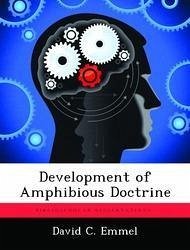Nicht lieferbar

Historical Review of the Development of Doctrine for Command Relationships in Amphibious Warfare
Versandkostenfrei!
Nicht lieferbar
This thesis traces the development of doctrine for command relationships in amphibious warfare. The study examines the command relationships employed in landing operations through World War I, with emphasis on Santiago in the Spanish-American War and Gallipoli in World War I as the driving forces behind joint and naval doctrine development. From this background, the thesis outlines the efforts of the Joint Board and Marine Corps Schools to codify their doctrine, primarily in the interwar years. The joint process led to Joint Action of the Army and the Navy and Joint Overseas Expeditions of 192...
This thesis traces the development of doctrine for command relationships in amphibious warfare. The study examines the command relationships employed in landing operations through World War I, with emphasis on Santiago in the Spanish-American War and Gallipoli in World War I as the driving forces behind joint and naval doctrine development. From this background, the thesis outlines the efforts of the Joint Board and Marine Corps Schools to codify their doctrine, primarily in the interwar years. The joint process led to Joint Action of the Army and the Navy and Joint Overseas Expeditions of 1927 and 1933, predecessors to Joint Publication 0-2, Unified Action Armed Forces. Naval doctrine begun by the Marine Corps Schools became the Navy's Fleet Training Publication 167, Landing Operations Doctrine, U.S. Navy, 1938, predecessor to Joint Publication 3-02, Joint Doctrine for Amphibious Operations. The thesis then examines the employment of that doctrine, and the doctrinal changes and lessons that resulted, in three major amphibious operations, WATCHTOWER (Guadalcanal), ICEBERG (Okinawa), and CHROMITE (Inchon). The study concludes with a discussion of the relevance of the historical development to today's doctrinal issues and provides recommendations for further research. This work has been selected by scholars as being culturally important, and is part of the knowledge base of civilization as we know it. This work was reproduced from the original artifact, and remains as true to the original work as possible. Therefore, you will see the original copyright references, library stamps (as most of these works have been housed in our most important libraries around the world), and other notations in the work. This work is in the public domain in the United States of America, and possibly other nations. Within the United States, you may freely copy and distribute this work, as no entity (individual or corporate) has a copyright on the body of the work. As a reproduction of a historical artifact, this work may contain missing or blurred pages, poor pictures, errant marks, etc. Scholars believe, and we concur, that this work is important enough to be preserved, reproduced, and made generally available to the public. We appreciate your support of the preservation process, and thank you for being an important part of keeping this knowledge alive and relevant.











